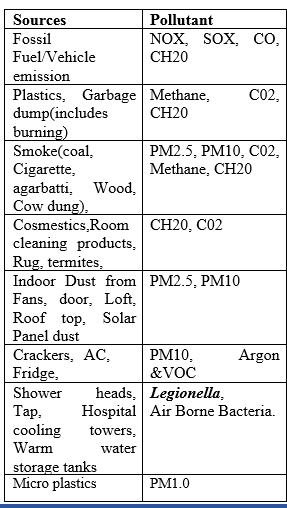This Research has been carried out with nshapiro & Solve Ninjas Saujanya, Taanika of ReapBenefit , an organization that solves Local Civic & Environmental issues in India with Youngsters as part of Remediation Kit Project for Indoor Air Quality.
Overview: The indoor air pollutants affect more than the outdoor ones. The concentration of household pollutants exceeds the standard set for the outdoors. These pollutants reach such a high level despite they are emitted in small volumes but they cannot escape (subject to ventilation). Indoor air pollution is more harmful and poses greater health hazards because on average a person spends nearly 10 to 14 hours indoors.
Introduction: The term "Indoor" is subjective and it can be any of the following: House (which is again subjective), Hostels, Office space (including Govt. offices, Banks), Restaurants, Hotels, Cafes, Hospitals, Schools (all kinds), Colleges, Religious Places, and Marriage Halls. The demography or location of a place plays a vital role in increasing Indoor Pollutants. (Ex: Office space situated near a Factory that emits smoke is viable to Breathe smoke air than that of people living in Apartments away from 10km to that Factory). Also, when we say Indoor, the Sq.ft / sq. meter Area of the Indoor Space should also be taken into account.
Sources:
Common Pollutants: Combustion, building materials, and bioaerosols are common Indoor pollutants. Radon, asbestos, pesticides, heavy metals, volatile organic matter, and tobacco & industry smoke are considered major indoor pollutants in developed countries & the combustion products of biomass fuels contribute most to indoor air pollution in developing nations like India.
Other Sources from Fuels: The incomplete combustion products of biomass fuels include suspended particulate matter, carbon monoxide, polyaromatic hydrocarbons, poly organic matter, formaldehyde, etc., which have adverse effects on health.
Combustion of coal: The combustion of coal results in the production of oxides of sulfur, arsenic, and fluorine.
Sources from Daily Usage Products: Pollutants such as aldehydes, volatile, and semi-volatile organic compounds are produced from resins, waxes, polishing materials, cosmetics, Toilet cleaning materials and binders. Also, more use of Incense Sticks, Agarbatti, Camphor, Crackers during festival time significantly cause discomfort in breathing and increase pollutants in indoor space. Certain research suggests that overuse of Electrical appliances like Induction stove, Microwave oven contributes to PM1.0 or less than that of PM0.5, PM0.3 ug/m3.
Biological Pollutants: Biological pollutants like dust mites, molds, pollen, and infectious agents produced in stagnant water, mattresses, carpets, Dust particles settled on top of the door roof, Fans, Floorspace, Loft, windows, & humidifiers pollute indoor air.
Other Sources: The un-noticed & most significant source of Indoor Air pollution is from Plastics we use (Biscuit & Milk cover, Bags, Tetra-packets, Pens, Microplastics, etc.) which are dumped in public area that forms an Open Garbage dump in nearby Land/ Lake area or in apartment Area that makes Dry & Wet Waste to get mixed results in the emission of Methane Gases. This develops into huge landfill, resulting in affecting Indoor Air due to the wind, rain that enters the space. Sometimes, people staying near Factory Zones might be affected. Coal, Paper, Cement, Heavy Electrical or factories where the burning of Substances exist that emits Ozone which is also an important indoor air Pollutant.
Common Across Any indoor space: In any Indoor Space, the contribution of some of our Daily use products (Cosmetics, Toilet cleaning products, Incense sticks, Agarbatti), some of Biological Pollutants (Dust from Fan, Door, Floor space, Carpets) makes easily prone to Air Pollution and cause diseases.
Unknown sources: Some of the pollutants arise from Water sources also, The Algae that gets formed in Tap, Shower Head, Water Tanks, Overhead Colling Towers and where warm water gets stored and contaminated due to the presence of Legionella, an Algae. Another Factor is the presence of Bacteria due to dust and pollen grains that affect Indoor Air.
The table shows the Sources & respective Indoor Air Pollutants

Diseases due to Air pollution: Conjunctivitis, Rhinitis, Sore throat, Bronchitis, Asthma, Allergies, Pneumonia are common types of diseases due to Indoor Air Pollutants.
Conclusion: The dimensions(Sq.ft area) of Indoor space, Ventilation, number of windows, kitchen spacing, Use of cooking fuel, Plants in homes, plays a significant contribution in reducing these Pollutants getting settled for a long time. Health, Education & work starts from the indoor space where we spend most of our time. Let us Take Action to Mitigate this Air Pollution Issue at Local level from our Indoor spaces.

3 Comments
Fantastic @silentsairam ! Thank you
Reply to this comment...
Log in to comment
The research has depth and yet it is detailed to give exact information! Great work
Reply to this comment...
Log in to comment
Amazing article. Any news or updates you'd recommend for next steps? The article is 3 years old so maybe there are new learnings, especially with all the indoor time we'd had over the past few years.
Is this a question? Click here to post it to the Questions page.
Reply to this comment...
Log in to comment
Login to comment.